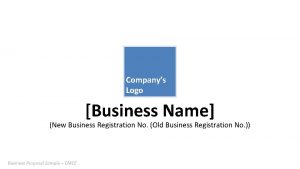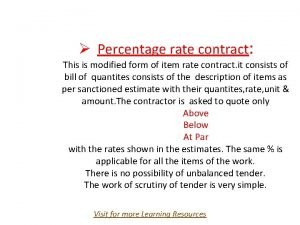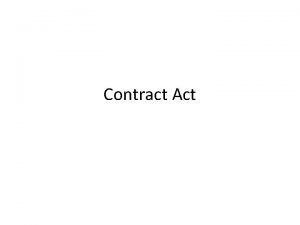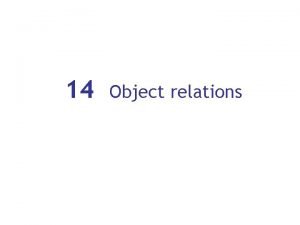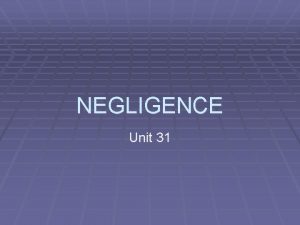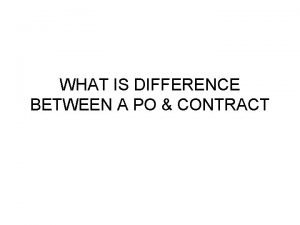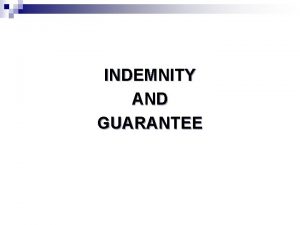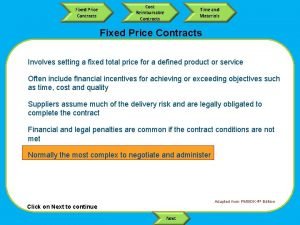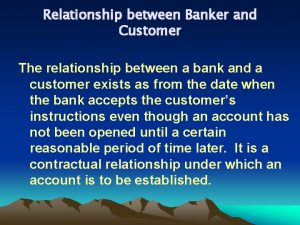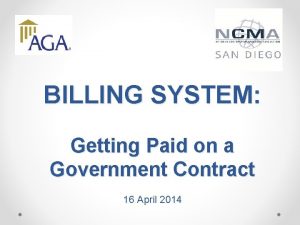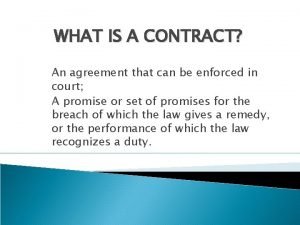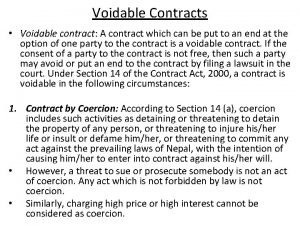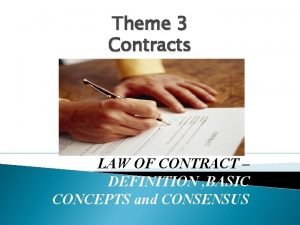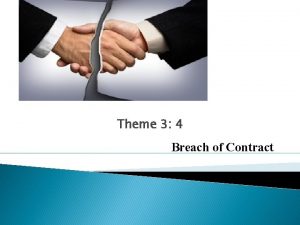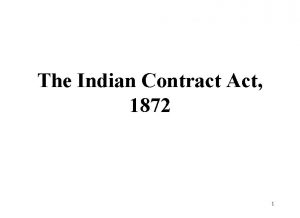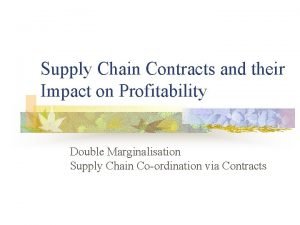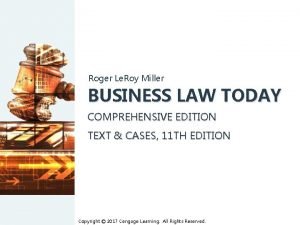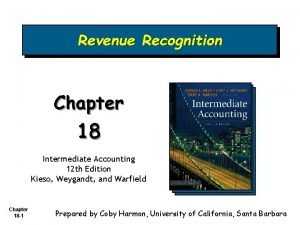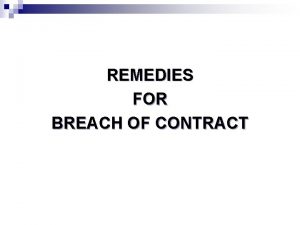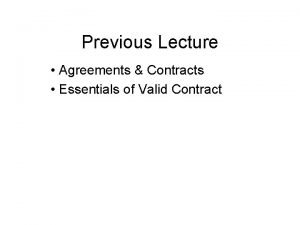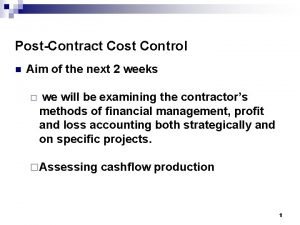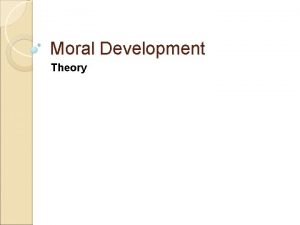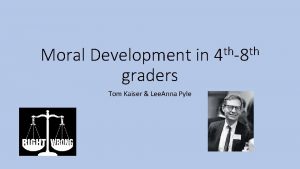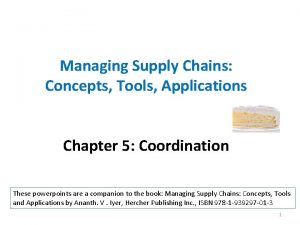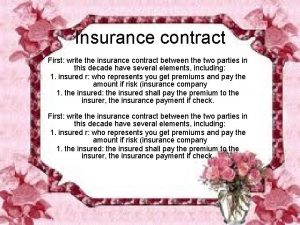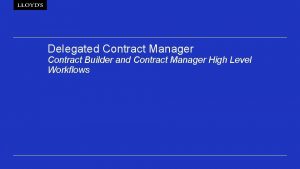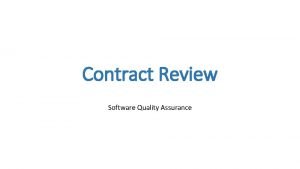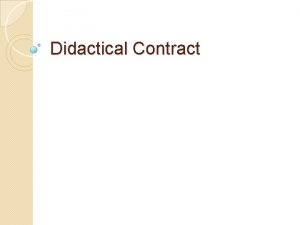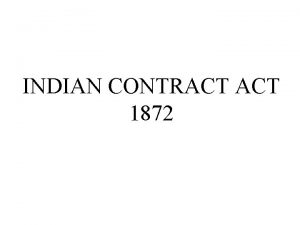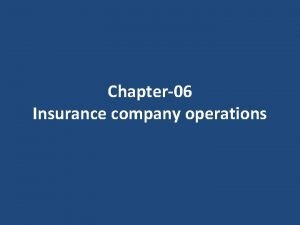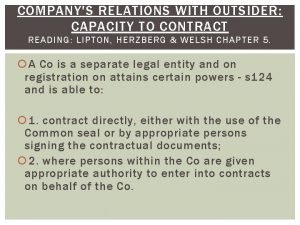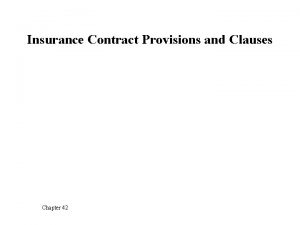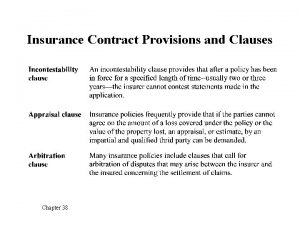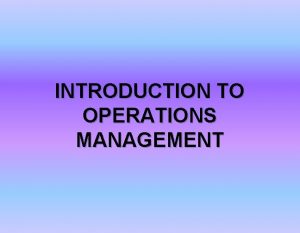INSURANCE 3 Insurance contract and insurance companys operations
















































- Slides: 48

INSURANCE 3 Insurance contract and insurance company’s operations

BENEFITS OF INSURANCE TO SOCIETY � Indemnification for loss which enables maintaining financial security � Reduction � Source � Loss of worry and fear of investment funds prevention � Enhancement of credit

INSURANCE LAW � Regulation of the business of insurance, � Regulation of the content of insurance policies, especially with regard to consumer policies, � Regulation of claim handling.

INSURANCE AS A CONTRACT � Insurance is a contract based upon money for a promise. The policyholder’s premium is consideration for the insurer’s agreement to pay a covered claim that may occur months, years or even decades in the future and where the amount of the claim is likely to be significantly greater than the premium collected. Once the premium is paid, the policyholder is dependent on the insurer’s ongoing ability and willingness to pay the claim should an insured loss occur.

� To have a valid insurance contract following requirements must be met: 1. 2. 3. 4. There must be offer and acceptance There must be an exchange of consideration There must be intention to create legal relationship The parties to the contract must be legally competent 5. The contract must be for a legal purpose (contract that encourages something illegal is contrary to public interest and cannot be enforced)

� Insurance contracts are unilateral contracts. That means that only one party, in this case insurer, makes a legally enforceable promise. By the contract of insurance the insurer undertakes to pay a claim or provide other services to the insured. After the first premium is paid the insurance is in force, but the insured cannot be legally forced to pay the premiums or to comply with the policy provisions.

� Insurance contract is a conditional contract. The insurer’s obligation to pay depends on whether the insured or the beneficiary has complied with all policy conditions. Conditions are provisions inserted in the policy that qualify or place limitations on the insurer’s promise to perform.

� In property insurance, insurance is a personal contract, which means that the contract is between the insured and the insurer. Strictly speaking, a property insurance contract does not insure property, but insures the owner of property against loss.

� Insurance policies sold to individuals are virtually all ‘contracts of adhesion’, as are most of the insurance contracts purchased by a commercial and public entities. � Adhesion contracts are characterized by the use of standard form agreements drafted exclusively by one party and for which there is little or no bargaining over terms other than price; the discretion or choice is whether to agree to the contract as written or forgo it altogether.

� The great majority of consumers will neither read nor necessarily understand the contract. � Policyholders may only become aware of important terms in their contract when an insurer denies a claim.

� An insurance contract is an aleatory contract where the values exchanged may not be equal and depend on the occurence of an uncertain event. � In contrast, other commercial contracts are commutative. The values exchanged by both parties are theoretically equal.

PARTS OF INSURANCE CONTRACT � Declarations � Definitons � Insuring agreement � Exclusions � Consitions � Miscellaneous provisions

� Courts and legislatures have long recognized that a pure freedom of contract approach to insurance regulation would often lead to unjust results and damage confidence in insurance market. ◦ therefore � Insurance is governed by a mix of statutes, administrative agency regulations and court rulings in order to control premium rates, prevent unfair practices by insurers and guard against the financial insolvency to protect assureds.

� In recent years insurance, like most other business endeavors has been globalized. � Since existing international norms necessarily leave much of insurance regulation to the discretion of each country, each jurisdiction must decide what level of intervention into the insurance market is most beneficial to its citizens.

� One of insurance characteristics is that it may be mandated by government or required as a condition of engaging in particular professional services or commercial transactions, e. g. car owner’s liability insurance, attorney’s professional insurance or medicine practice insurance.

To what extent we should regulate insurance market? � What do you think?

To what extent we should regulate insurance market? � Alternatives range from exclusive government or publicly-run insurers, to a purely freemarket regulatory system where government’s role is limited largely to solvency review.

Common Regulatory Themes 1. Solvency and Prudential Regulation 2. Insurance Markets 3. Consumer Protection and Market Conduct Regulation

Solvency – prudential regulation � Solvency regulation includes mandating and enforcing capital requirements, claim reserves and investment restrictions, as well as insolvency administration.

Insurance Markets � Insurance Markets includes regulating corporate structure, mergers and acquistions, market entry and withdrawal, underwriting and risk classifiaction requirements and restrictions, reinsurance and the regulation of insurance intermediaries.

Consumer Protection � Consumer Protection can be considered as both the regulatory tools to enforce insurance laws (e. g. licensing of insurers and insurance intermediaries, regulating the terms of the insurance contract, and market conduct exams) as well as government entities interdeciding directly on behalf of consumers, which can range from mediating individual insurer/policyholder disputes to regulatory action and litigation against specific insurance market participants.

How is insurance marketed? � There are various types of insurance companies as well as several methods of marketing their product. � The companies are generally classified by the type of corporate structure under which they operate. � Private insurance companies � Public insurance companies

Private insurance companies � Stock companies � Mutual companies � Reciprocal insurance exchanges

Stock insurance companies � Corporations chartered by a state to conduct an insurance business. To start te business, individuals buy shares and these funds are used to fund the insurance company’s operations until the organization generates enough business to pay operating costs out of current income. The paid-in capital also serves as the surplus fund guaranteeing the fulfillment of policy obligations during the early days of the organization.

Stock insurance companies � The characteristics of a stock insurance company are: �paid-in capital appears in its financial statement, �the board of directors is elected by the stockholders, �some portion of earnings may be paid to stockholders as dividends on their stock

Mutual insurance companies � Mutual insurance companies are owned by their policyholders. Before they can receive authority to operate they must meet a statutory requirement on the amount of premium and number of policies that it can immediately issue upon authorization. � There is no capital stock outstanding, the members of the board of directors are elected by the policyholders and the funds remaining after paying all costs of operations (including additions to all surplus and contigency funds) are distributed to the policyholders as policy dividends.

Reciprocal insurance exchange � Reciprocal insurance exchange firms are also called inter-insurance exchange. They are similar to a mutual insurance company as they are owned by their members. The policyholders, called subscribers, establish an exchange and insure one another. They also contract with an attorney-in-fact to operate the exchange under the control of an advisory board. � Each policyholder is both an insured an insurer since the contracts are exchanged on a reciprocal basis. A premium called a deposit is paid in advance. Dividends may be paid to the subscribers based on operating results.

Other private insurers � Captive insurers - a company that provides riskmitigation services for its parent company or for a group of related companies. A captive insurance company may be formed if the parent company is unable to find an outside firm to insure against a particular business risk if the parent company determines that the premiums it pays to the captive insurance company may create a tax savings or if the insurance the captive insurance company provides is more affordabor offers better coverage for the parent company's risks.

Other private insurers � Savings bank life insurance - a type of life insurance only allowed in certain states, Massachusetts, New York and Connecticut. This insurance is sold by a savings bank.

Public insurance companies � There are insurance programs that are underwritten by both federal governemnt as well as state governments. Some of theme are voluntary while others are compulsory.

INSURANCE COMPANY OPERATIONS � Insurance business is specific as the insurer does not know in advance what its actual costs are going to be. It is very hard to reliably estimate them. The total premiums charged for given line of insurance may be inadequate for paying all claims and expenses during the policy period. It is only after the period of protection has expired that an insurer can determine its actual losses and expenses.

INSURANCE COMPANY OPERATIONS � Rate making � Underwriting � Production � Claims settlement � Reinsurance � Investments � Accounting � Legal services � Loss control � Information systems

RATE MAKING � Rate making refers to the pricing of insurance and the calculation of insurance premiums. It is done by actuaries, usually mathematicians involved in all phases of insurance company operations, including planning, pricing and research. � The premium paid by the insured is the result of multiplying a rate determined by actuaries by the number of exposure units, and adjusting the premium by various rating factors.

UNDERWRITING � Underwriting refers to the process of selecting, classifying, and pricing applicants for insurance. � Underwriter is a person who decides whether to accept or to reject an application. � Underwriting management of an insurance company establishes guidelines which cover the types of policies, procedures and exposures that an underwriter uses in selecting insureds, so called underwriting policy.

UNDERWRITING � If the underwriting standards are not met, the insurance is denied, or an extra premium must be paid, or the coverage offered may be more limited.

UNDERWRITING PRINCIPLES � Attain an underwriting profit � Select prospective insureds according to the company’s underwriting standards �Adverse selection – the tendency of people with the higher-than-average chance of loss to seek insurance at standard (average) rates, which if not controlled by underwriting, will result in higher-than-expected loss levels � Provide equity among policyholders

UNDERWRITING IN PROPERTY INSURANCE � C-O-P-E �C stands for Construction (wood, brick, concrete, combustible/non-combustible) � O stands for Occupancy (single, multi-tenat, manufacturing, retail) � P stands for Protection (fire, theft, public, private) � E stands for Exposure (neighborhood, woods, water, other properties)

UNDERWRITING IN PROPERTY INSURANCE � Inspection required. report of the property may be

UNDERWRITING IN LIFE INSURANCE � Age � Gender � Weight � Occupation � Personal and family health history � Hazardous hobbies � Amount of insurance requested

UNDERWRITING IN LIFE INSURANCE � Physical needed. examination by a doctor may be

PRODUCTION � Production refers to the sales and marketing activities of insurers. � People who sell insurance are frequently referred to as producers. � No business is produced until a policy is sold.

AGENTS AND BROKERS � Agent – someone who legally represents the principal (insurance company) and has the authority to act on the principal’s behalf. The principal is legally responsible for the acts of an agent whenever the agent is acting within the scope of his or her authority granted or implied by the principal. � Broker – someone who legally represents the insured even though he or she receives a commission from the insurer. A broker legally does not have the authority to bind the insurer. � Brokers usually enter into separate agency contracts with few insurers.

CLAIMS SETTLEMENT � From the insurer’s viewpoint , there are several basic objectives of settling claims: ◦ Verifications of covered loss ◦ Fair and prompt payment of claims ◦ Provision of personal assistance to the insured

CLAIMS SETTLEMENT - STEPS 1. 2. 3. 4. 5. Notice of loss Investigation of the claim. Filing a proof of loss. Decision concerning payment. Possible dispute over the amount to be paid. Failure of the insured to cooperate with the insurance company usually results in denial of the claim.

REINSURANCE � Reinsurance is an arrangement by which the primary insurer that initially writes the insurance transfers to another insurer part or all the potential losses associated with insurance. � Reinsurance is insurance that is purchased by an insurance company from one or more insurance companies (the "reinsurer") as a means of risk management, sometimes in practice including tax mitigation and other reasons.

REINSURANCE � The ceding company and the reinsurer enter into a reinsurance agreement which details the conditions upon which the reinsurer would pay a share of the claims incurred by the ceding company. The reinsurer is paid a "reinsurance premium" by the ceding company, which issues insurance policies to its own policyholders. � The amount of insurance retained by the ceding company for its own account is called the retention limit, or net retention. The amount of insurance ceded to the reinsurer is known as the cession.

TYPES OF REINSURANCE � Facultative reinsurance � Treaty reinsurance � Alternatives to traditional reinsurance: ◦ Securitization of risk – insurable is transferred to the capital markets through the creation of a financial instrument, such as a catastrophe bond, futures contract, options contract, or other financial instrument.

INVESTMENTS � Due to the fact that premiums are paid in advance, they can be invested until needed to pay claims and expenses.
 Chemical companys
Chemical companys Solar system companys
Solar system companys Names of companys
Names of companys Movie companys
Movie companys Microsoft companys
Microsoft companys 5 step model ifrs 15
5 step model ifrs 15 Contingent contract and wagering contract
Contingent contract and wagering contract Nature of fire insurance contract
Nature of fire insurance contract Item rate contract
Item rate contract Contract costing meaning
Contract costing meaning Quantum meruit
Quantum meruit Andrew penfold linklaters
Andrew penfold linklaters Equals and hashcode contract
Equals and hashcode contract Contract and lease management sap
Contract and lease management sap Sayers v harlow
Sayers v harlow Chesmore vs richards
Chesmore vs richards Difference between po and contract
Difference between po and contract Contract of indemnity and guarantee
Contract of indemnity and guarantee Time and materials contract
Time and materials contract Absolute contract
Absolute contract Mail @ mepindia.co.in
Mail @ mepindia.co.in Termination of banker customer relationship
Termination of banker customer relationship Contract and billing system
Contract and billing system World class contract manufacturing
World class contract manufacturing What is quasi contract
What is quasi contract Voidable
Voidable Unenforceable contract
Unenforceable contract Sra training contract
Sra training contract Classification of contract
Classification of contract Definition of corporate personality
Definition of corporate personality Malperformance examples
Malperformance examples Quantum meruit
Quantum meruit Nature of indian contract act 1872
Nature of indian contract act 1872 Buy back contract supply chain example
Buy back contract supply chain example Sewp iv contract holders
Sewp iv contract holders Underprotech
Underprotech Quasi contract example
Quasi contract example Completed contract method
Completed contract method Breacof
Breacof Computer contracts
Computer contracts Contract management framework template
Contract management framework template Privacy of contract
Privacy of contract Essentials of valid tender
Essentials of valid tender Post contract cost control in construction
Post contract cost control in construction Oracle contract lifecycle management
Oracle contract lifecycle management Conventional morality definition
Conventional morality definition Postconventional morality example
Postconventional morality example Social contract
Social contract Take or pay contract
Take or pay contract


